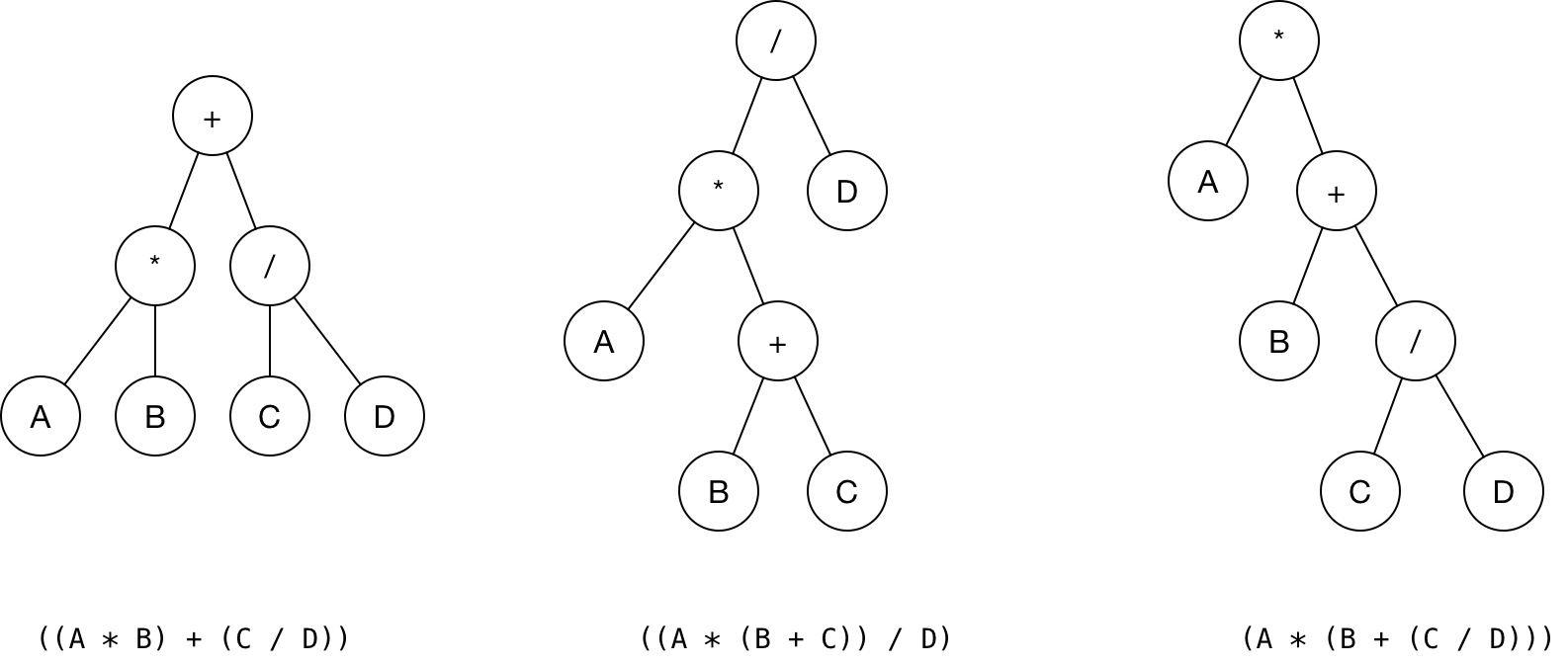Infix, Postfix and Prefix notations are three different but equivalent ways of writing expressions.
It is easiest to demonstrate the differences by looking at examples of operators that take two operands.
X + Y Operators are written in-between their operands.
The expression: A * ( B + C ) / D translates to "Add B and C together, multiply the result by A, then divide by D to give the final answer."
Infix notation needs extra information to make the order of evaluation of the operators clear:
-
rules built into the language about operator precedence and associativity
-
parentheses
( )to allow users to override these rules
For example, the usual rules for associativity say that we perform operations from left to right, so the
multiplication by A is assumed to come before the division by D. Similarly, the usual rules for precedence
say that we perform multiplication and division before we perform addition and subtraction.
X Y + Operators are written after their operands.
The infix expression given above is equivalent to A B C + * D / The order of evaluation of operators is
always left-to-right, and brackets cannot be used to change this order. Because the + is to the left
of the * in the example above, the addition must be performed before the multiplication.
Operators act on values immediately to the left of them. For example, the + above uses the B and C.
We can add (totally unnecessary) brackets to make this explicit: ( (A (B C +) *) D /)
Thus, the * uses the two values immediately preceding: A, and the result of the addition.
Similarly, the / uses the result of the multiplication and the D.
+ X Y Operators are written before their operands.
The expressions given above are equivalent to / * A + B C D. As for Postfix, brackets are superfluous. However,
operators are evaluated left-to-right. Operators act on the two nearest values on the right.
I have again added (totally unnecessary) brackets to make this clear: (/ (* A (+ B C) ) D)
Although Prefix operators are evaluated left-to-right, they use values to their right, and if these values themselves involve computations then this changes the order that the operators have to be evaluated in. In the example above, although the division is the first operator on the left, it acts on the result of the multiplication, and so the multiplication has to happen before the division (and similarly the addition has to happen before the multiplication).
Because Postfix operators use values to their left, any values involving computations will already have been calculated as we go left-to-right, and so the order of evaluation of the operators is not disrupted in the same way as in Prefix expressions.
In all three versions, the operands occur in the same order, and just the operators have to be moved to
keep the meaning correct. (This is particularly important for asymmetric operators like subtraction and
division: A - B does not mean the same as B - A; the former is equivalent to A B - or - A B, the
latter to B A - or - B A.
Examples:
|
|
|
|
|
|
|
|
|
|
|
|
The most straightforward method is to start by inserting all the implicit brackets that show the order of evaluation:
Infix |
Postfix |
Prefix |
( (A * B) + (C / D)) |
( (A B *) (C D /) +) |
(+ (* A B) (/ C D) ) |
( (A * (B + C) ) / D) |
( (A (B C +) *) D /) |
(/ (* A (+ B C) ) D) |
(A * (B + (C / D) ) ) |
(A (B (C D /) +) *) |
(* A (+ B (/ C D) ) ) |
You can convert directly between these bracketed forms simply by moving the operator
within the brackets e.g. (X + Y) or (X Y +) or (+ X Y). Repeat this for all the
operators in an expression, and finally remove any superfluous brackets. You can use a
similar trick to convert to and from parse trees - each bracketed triplet of an operator
and its two operands (or sub-expressions) corresponds to a node of the tree.
The corresponding parse trees are:

Adapted from: http://www.cs.man.ac.uk/~pjj/cs212/fix.html